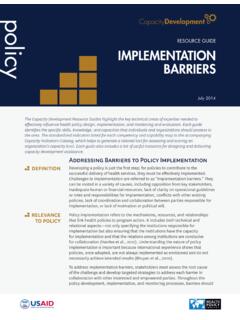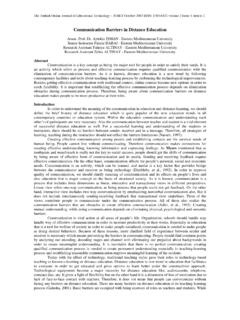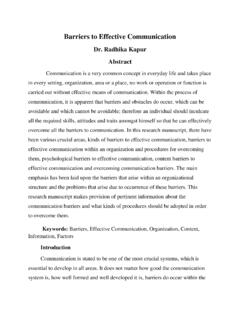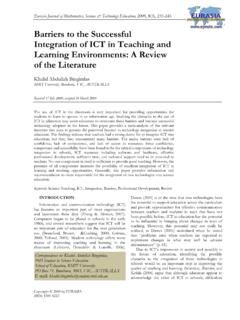Transcription of RESOURCE GUIDE IMPLEMENTATION BARRIERS
1 CapacityDevelopment RESOURCE GUIDE . IMPLEMENTATION . BARRIERS . July 2014. The Capacity Development RESOURCE Guides highlight the key technical areas of expertise needed to effectively influence health policy design, IMPLEMENTATION , and monitoring and evaluation. Each GUIDE identifies the specific skills, knowledge, and capacities that individuals and organizations should possess in the area. The standardized indicators listed for each competency and capability map to the accompanying Capacity Indicators Catalog, which helps to generate a tailored tool for assessing and scoring an organization's capacity level. Each GUIDE also includes a list of useful resources for designing and delivering capacity development assistance.
2 Addressing BARRIERS to Policy IMPLEMENTATION DEFINITION Developing a policy is just the first step; for policies to contribute to the successful delivery of health services, they must be effectively implemented. Challenges to IMPLEMENTATION are referred to as IMPLEMENTATION BARRIERS . They can be rooted in a variety of causes, including opposition from key stakeholders, inadequate human or financial resources, lack of clarity on operational guidelines or roles and responsibilities for IMPLEMENTATION , conflicts with other existing policies, lack of coordination and collaboration between parties responsible for IMPLEMENTATION , or lack of motivation or political will. RELEVANCE Policy IMPLEMENTATION refers to the mechanisms, resources, and relationships TO POLICY that link health policies to program action.
3 It includes both technical and relational aspects not only specifying the institutions responsible for IMPLEMENTATION but also ensuring that the institutions have the capacity for IMPLEMENTATION and that the relations among institutions are conducive for collaboration (Hardee et al., 2012). Understanding the nature of policy IMPLEMENTATION is important because international experience shows that policies, once adopted, are not always implemented as envisioned and do not necessarily achieve intended results (Bhuyan et al., 2010). To address IMPLEMENTATION BARRIERS , stakeholders must assess the root cause of the challenge and develop targeted strategies to address each barrier in collaboration with other interested and empowered parties.
4 Throughout the policy development, IMPLEMENTATION , and monitoring processes, BARRIERS should H E A LT H. POLICY. P R O J E C T. IMPLEMENTATION BARRIERS . be continually assessed and addressed. IMPLEMENTATION is an ongoing process of decision making by key actors who work in complex policy and institutional contexts and face pressures from interested as well as opposing parties. As such, the motivation, flow of information, and balance of power and resources among stakeholders influences policy IMPLEMENTATION processes. Ultimately, overcoming policy IMPLEMENTATION BARRIERS will require commitment and perseverance by a range of stakeholders, possibly over a prolonged period (Bhuyan et al., 2010). KEY The ability to address policy IMPLEMENTATION BARRIERS is a key capability for CAPABILITIES government, policymakers, and civil society.
5 Addressing policy BARRIERS requires individual and institutional skills and competencies to understand the policy environment governing the health system, the configuration of the health system in the context of the government structure, and the needs of beneficiaries/. clients and implementers. It requires the ability to critically assess the true root of policy IMPLEMENTATION BARRIERS whether it is sociological, political, structural, institutional, or cultural and to craft targeted solutions to address them. Finally, it requires engendering stakeholder buy-in and commitment to take action, determining resources required for the proposed solution, implementing a solution to remove the barrier, and enacting accountability mechanisms to ensure that BARRIERS have been addressed (Bhuyan et al.)
6 , 2010; Cross et al., 2001). PERFORMANCE High capacity for addressing policy IMPLEMENTATION BARRIERS includes being IDEAL able to Gather and synthesize different types of information from various sources Elicit feedback from implementers, partners, and beneficiaries to identify BARRIERS to successful policy IMPLEMENTATION and explore root causes Identify solutions to challenges and advocate for corrective action Maintain systems to facilitate regular reviews of IMPLEMENTATION experiences, share best practices across groups, and integrate lessons learned into subsequent policies and action plans At the highest level of performance, individuals and organizations consider . throughout the policy process the potential roadblocks and steps to overcome them.
7 Attention to BARRIERS starts with policy design and strategic action planning and continues during policy IMPLEMENTATION and thus policy monitoring to track outcomes, identify challenges, and be alert to unintended consequences or inequities. In a high-functioning system, the gap between policy and practice narrows and BARRIERS to realizing results are identified and removed. In the ideal, the following would exist: Policies translated into effective operational rules and guidelines Efficient allocation and coordination of human and financial resources to achieve policy goals Regular systems to review policy and program decisions ( , mid- and end- term reviews, multisectoral forums), with broad-based participation Capacity Development RESOURCE GUIDE 2.
8 IMPLEMENTATION BARRIERS . individual competencies KNOWLEDGE OF. Local and national policy environment, laws, and the configuration of the health IB 1. system within government structures Specific aspects of the policy to be implemented, including policy goals, strategies IB2. and action plans, roles of different institutions and stakeholders, and available resources SKILLS TO BE ABLE TO. Collect, analyze, and present quantitative and qualitative data to identify BARRIERS and IB3. develop evidence-based solutions Engage diverse stakeholders in constructive policy dialogue to identify and address IB4. BARRIERS at the appropriate level (national, district, facility, etc.). Understand the socio/political/structural/institutional /cultural root of policy IB7.
9 IMPLEMENTATION BARRIERS and craft targeted solutions to address them Conduct cost analysis that aligns budget allocations with the actual resources IB6. required to implement policies Draft operational policy guidance and rules to implement change IB8. Communicate evidence-based recommendations and influence decisionmakers to IB5. take corrective action Monitor and document the policy IMPLEMENTATION process and impact of adopted IB9. solutions ATTITUDES/VALUES/ATTRIBUTES. Elicits stakeholder buy-in and commitment to ongoing engagement IB10. organizational capabilities TECHNICAL ABILITY TO. Develop IMPLEMENTATION plans that include clearly defined policy goals, strategies, IB11. action plans, monitoring mechanisms, and operational guidelines Integrate best practices and successful approaches to overcoming BARRIERS into IB12.
10 Organizational and decision-making processes Capacity Development RESOURCE GUIDE 3. IMPLEMENTATION BARRIERS . RELATIONAL ABILITY TO. Leverage multisectoral partnerships and resources to collectively address complex IB13. BARRIERS at the appropriate level and facilitate IMPLEMENTATION (national, district, facility, etc.). Provide training, technical assistance, and mentoring to other organizations on IB21. addressing IMPLEMENTATION BARRIERS ORGANIZATIONAL OPERATIONS AND MANAGEMENT TO SUPPORT. A knowledge management system to share best practices in policy IMPLEMENTATION IB15. and lessons learned internally and externally Regular interactions among staff responsible for program IMPLEMENTATION , monitoring IB16.














